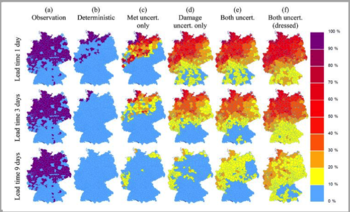WP1A: Impact modelling and risk-based warnings
WP1A
Image Credit: Pardowitz, T. et al. (2016): An analysis of uncertainties and skill in forecasts of winter storm losses, Nat. Hazards Earth Syst. Sci., 16, p. 2397.
Over the past decades, weather forecasts have been continuously improved. In addition to pure weather forecasting, the prediction of weather impacts is now becoming more and more important. Particularly in the case of extreme weather events, understanding the risks and impacts of the events is of particular importance in order to be able to give relevant instructions for actions and initiate successful protective measures. Studies show that the joint communication of information about a meteorological event and the expected impacts can lead to better reactions from the warning recipients (e.g. Weyrich et al. 2018).
Impact modelling contributes to the estimation of weather impacts. Impact data and statistical methods can be used to quantify the impacts of meteorological events. Within the framework of WEXICOM, statistical impact models are being developed for three different areas: storm damage to residential buildings (Pardowitz et al. 2016), impacts of extreme convective precipitation events on fire brigade operations (Pardowitz et al. 2017, 2018), and weather impacts on road traffic and accidents (Becker et al. 2020). These impact models are used to derive probabilistic risk indices. These are implemented in real-time forecasting systems and tested by potential users. Impact models as developed in WEXICOM are the basis for the development of risk-based warning systems.
Furthermore, a network of Internet-of-Things-based measurement devices is being set up within WEXICOM as part of a Citizen Science project. Statistical methods for the calibration of the measuring devices will be developed for this network.

